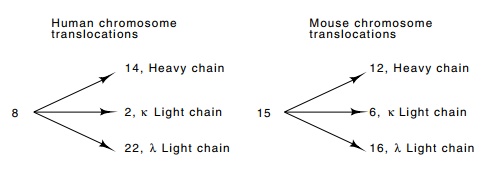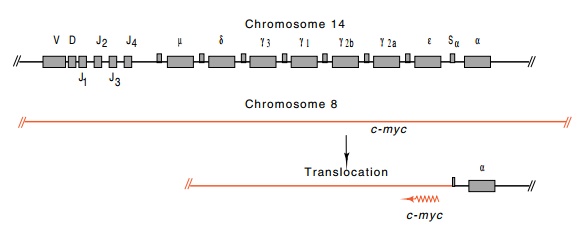Chapter: Genetics and Molecular Biology: Oncogenesis, Molecular Aspects
Transformation and Oncogenesis by Damaging the Chromosome
Transformation and Oncogenesis by Damaging the
Chromosome
Epidemiologists have long recognized that certain
chemicals induce cancer, and Ames has shown that many bacterial mutagens are
human carcinogens. The mutagenicity of chemicals, as detected by the rever-sion
of a set of bacterial histidine mutants, correlates well with their
carcinogenicity. Therefore chromosome damage in the form of muta-tions or small
insertions and deletions is one cause of cancer. The next section explains how
the exact base change responsible for induction of one particular cancer was
determined.

Figure
23.3 Human and mouse translocations
associated with cancers of theimmune system.
In addition to small lesions, chromosomal
rearrangements can alter either the expression or the structure of RNAs or
proteins. Such chro-mosomal rearrangements are frequently observed in a class
of cancers called Burkitt’s lymphomas in humans and plasmacytomas in mice. These
are cancers of immunoglobulin-secreting cells, and therefore it is likely that
the chromosome rearrangements in Burkitt’s lymphomas actually involve the
immunoglobulin genes. Indeed, the chromosomes involved in the rearrangements
usually are those that contain the heavy and light immunoglobulin genes (Fig.
23.3). The actual site of the chromosomal translocation in a Burkitt’s lymphoma
can be identified by cloning the heavy chain constant region from lymphoma and
non-lymphoma cells. Many lymphomas contain a translocation that fuses part of
chromosome 8 to a heavy chain switch region on chromosome 14 (Fig. 23.4). The
junction of the translocation sometimes contains a sequence resembling the DNA
it replaced, implying that a recombina-tion event, or an immunoglobulin
switch-related event, was responsible for the translocation. The DNA that has
been translocated to the immu

Figure
23.4 Schematic of the heavy chain
region of human chromosome 14and the approximate location of the material from
chromosome 8 that is translocated to chromosome 14. Transcripts originating in
the region are also shown.
As
a result of the translocation, its expression is deregulated and its gene is
often slightly rearranged. Similar gene translocations of c-myc are also involved with mouse plasmacytomas.
Related Topics